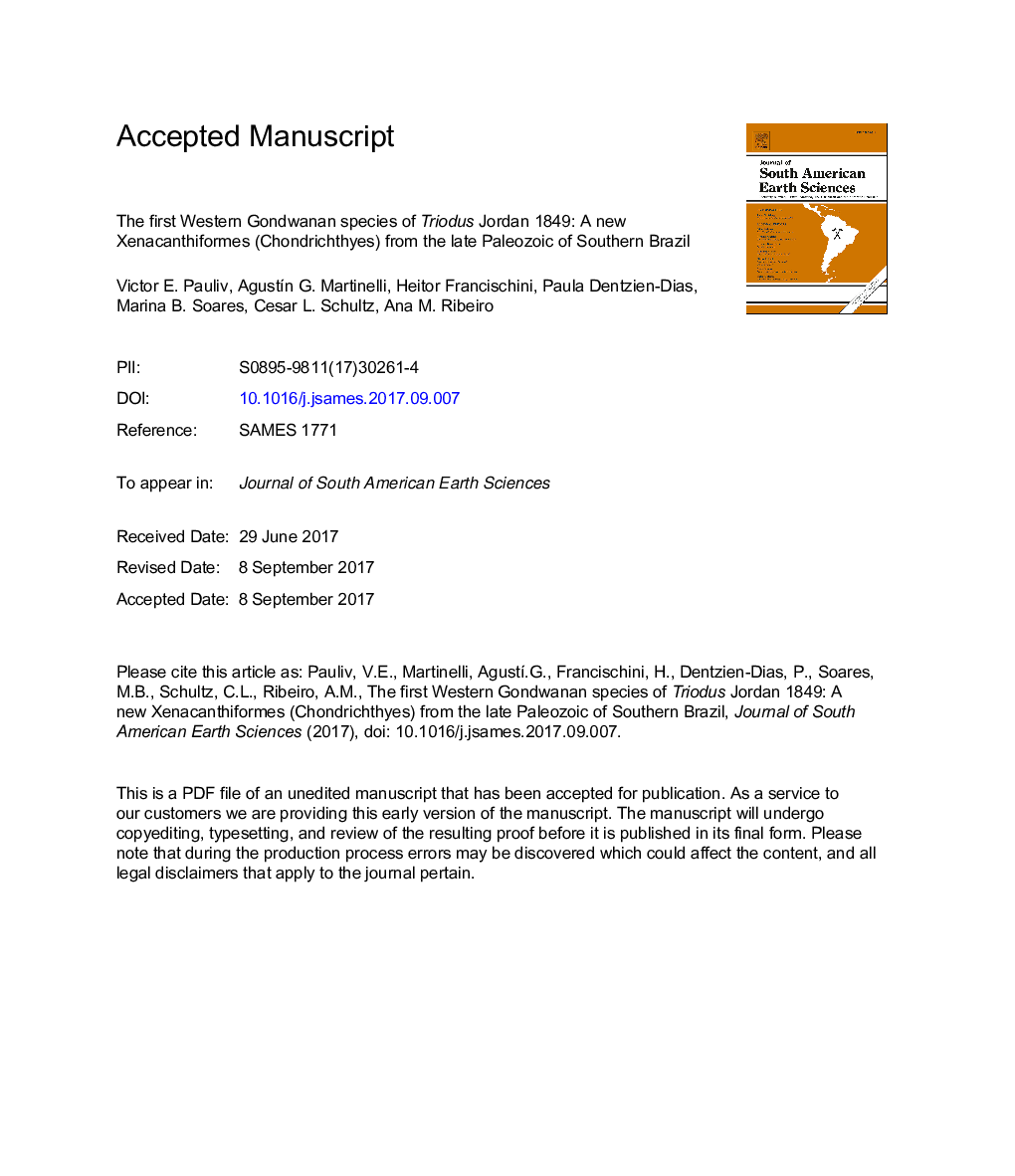| کد مقاله | کد نشریه | سال انتشار | مقاله انگلیسی | نسخه تمام متن |
|---|---|---|---|---|
| 8907783 | 1635130 | 2017 | 41 صفحه PDF | دانلود رایگان |
عنوان انگلیسی مقاله ISI
The first Western Gondwanan species of Triodus Jordan 1849: A new Xenacanthiformes (Chondrichthyes) from the late Paleozoic of Southern Brazil
دانلود مقاله + سفارش ترجمه
دانلود مقاله ISI انگلیسی
رایگان برای ایرانیان
کلمات کلیدی
موضوعات مرتبط
مهندسی و علوم پایه
علوم زمین و سیارات
علوم زمین و سیاره ای (عمومی)
پیش نمایش صفحه اول مقاله

چکیده انگلیسی
Triodus is a well-known genus of Xenacanthiformes, previously recorded from the late Bashkirian (Lower Pennsylvanian, Carboniferous) to the middle Artinskian (Cisuralian, Permian), mainly from Laurasian deposits (Europe and USA). For the first time, this genus is recorded from the Western Gondwana, based on isolated teeth that are referred to Triodus richterae sp. nov. The new species were found associated with other shark teeth (another xenacanthiforms and a possible euselachian), palaeoniscoid teeth and scales, labyrinthodont teeth, tetrapod bony remains, macroscopic charcoal and leaf fragments. This fossil assemblage was collected in a conglomerate layer from the Barro Alto site (São Gabriel municipality, Rio Grande do Sul State, Brazil), with an estimated Capitanian age, from the Morro Pelado Member, Rio do Rasto Formation, Paraná Basin. The new species has teeth with an almost oval base and the aboral surface has a smooth concavity and a rounded to horseshoe-shaped basal tubercle. The coronal surface of these teeth has a tricuspid crown, a rhomboid-shaped coronal button with rounded edges with a lingually directed shaft and some oral foramina predominantly situated at the lingual margin of the base and flanking the lingual shaft. The lateral cusps bear a variable number of non-branching vertical cristae, distributed from the apex to their proximal portion, making the transversal section of these cusps asterisk-shaped. Microstructurally, these teeth have both base and cusps composed of orthodentine with an opened pulp cavity. T. richterae sp. nov. represents the youngest species of Triodus, considering it comes from Capitanian (late Guadalupian) beds, which are at least 15 Ma younger than T. kraetschmeri, the previously youngest species of this genus. The depositional interpretation, as well as the fossil assemblage in the type locality of the new species and of the Rio do Rasto Formation as a whole, indicates another freshwater record for xenacanthid sharks.
ناشر
Database: Elsevier - ScienceDirect (ساینس دایرکت)
Journal: Journal of South American Earth Sciences - Volume 80, December 2017, Pages 482-493
Journal: Journal of South American Earth Sciences - Volume 80, December 2017, Pages 482-493
نویسندگان
Victor E. Pauliv, AgustÃn G. Martinelli, Heitor Francischini, Paula Dentzien-Dias, Marina B. Soares, Cesar L. Schultz, Ana M. Ribeiro,